The United States of Murder Inc. #1 (Marvel Icon, $3.95)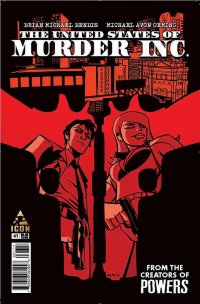
By Jeb D.
When the best pop culture “what if” concepts come along, there’s an “of course” moment for the reader/viewer; it might never have occurred to you or me to extract prehistoric DNA from the guts of preserved mosquitos, but the idea of science wreaking havoc by recreating dinosaurs is a definite “of course” moment. You or I might not share Kieron Gillen’s intense interest in the horrors of WW2, but when Uber offers us “What if the Axis had created super-soldiers?“, there’s that same sense of a concept that is both original and inevitable. I’m not entirely sure that the question “What if the Mafia seceded from the United States?” carries the same sense of satisfying inevitability. From The Godfather, through its sequels, its successors like Goodfellas and Casino, right down to The Sopranos, the trajectory of the American Mob story has not been one of separation, but of integration into the fabric of American life, a transition from the feudal banditry of its Sicilian origins into either (take your pick) a festering infection on the national body politic, or a shamefully inevitable pillar of a capitalist economy. Building a coherent, plausible (if not necessarily “realistic”) story of a separate Mob-ruled nation rising in opposition to the United States is going to need some serious spadework on the part of writer Brian Michael Bendis, artist Michael Avon Oeming, and colorist Taki Soma (Oeming’s wife), to pull off.
As if to acknowledge this, the Powers creative team here gives us a double-sized first issue (including a reproduction of Bendis’ original typo-laden script), because there’s a hell of a lot of heavy lifting to be done to bring the reader far enough into the story to hook us: world-building is half the job, character development the other, and Bendis and Oeming put every panel to good use in that regard; 22 pages would likely have left us short in one department or the other.
Our protagonist is Valentine Gallo, whose blood ceremony of becoming a “made man” is presented here as a combination of princely anointing and family holiday: kind of a sanguinary bar mitzvah. Valentine is regarded as being of important lineage, so he’s almost immediately thrust into an assignment for the government, and his neophyte status in the dark politics of this world allows him to share the reader’s perspective as he journeys for the first time out of “the territories,” to Washington, D.C., on what he takes to be a diplomatic mission of some kind (and, naturally, things don’t go quite as planned). The first half of this issue handles the world-building, the second half brings the sex, violence, action, double-dealing, and dark secrets that you’d expect. Valentine’s your typical callow youth setting out on manhood’s journey, but his first steps are intriguing enough that we’re happy to take accompany him. Most of the rest of the cast is also out of stock (mobsters, doting mothers, femmes fatale), but the dialog is appropriately snappy; it wouldn’t be hard to hear many of the supporting characters read in the voices of Joe Pesci or James Gandolfini. Bendis also manages to wrap up this issue with a pair of hooks that pretty much demand that the reader come back for issue #2.
I’m not sure it pays to step back and examine this world in too much detail—in a way, I’m sort of reminded of Bomb Queen, where you wonder how long a formally- structured community of predators can exist without completely exhausting its prey, but Oeming’s brisk (to the point of frenetic) art whips you along so that such questions don’t come up until after you’ve finished the book. Actually, if there’s one area about TUSMI that slightly disappoints me, it’s the rushed feeling I get from Oeming’s work, compared to the way he makes even the busiest, densest issue of Powers or The Victories feel clean, clear, and to the point. Granted, I’m picking nits about whether one of today’s top comic artists is at the top of his game, or only close to it, but I did come away feeling that I was working harder to lose myself in this environment than is usually the case with his work.
I’m still not entirely convinced that there’s a case to be made for La Cosa Nostra taking the place of Iran, North Korea, or Putin’s Russia as the principal international thorn in America’s side, but I’m sufficiently engaged in Valentine’s story to stick with it for now.
Rating: 




Out of a Possible 5 Stars
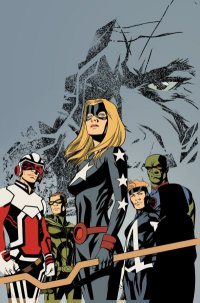 The New 52: Future’s End #0-2 (DC Comics, Free/$2.99 ea)
The New 52: Future’s End #0-2 (DC Comics, Free/$2.99 ea)
Justice League United #1 (DC Comics, $3.99)
by Graig Kent
Like so many olde timey DC Comics fans, I’d all but given up on the New 52. I have a smattering of books I read from DC each month, almost all somewhat disconnected from any sense of it being a shared universe: Batman in “Year Zero” has successfully removed itself from anything “now” into being a stand-alone arc (despite other books shoehorning themselves into the “Year Zero” brand); Wonder Woman is a single story told in multiple arcs with a clear direction and nearly no outside interference; Green Arrow is rebuilding the character and his mythology to embrace the successes of the television program. But any series that has tried to flagrantly seed itself into and connect together this new universe has pushed me away in quick measure. I went from reading about two dozen DC books every month to less than a half-dozen in the transition.
I first entered the DC Universe head first immediately following the Crisis on Infinite Earths (a hard reboot, though still softer than the New 52) and there I waded for over 25 years, surrounded by, and fully invested in DC both as a company and as a product. The 2011 reboot demolished a home I spent years investing in and built in its place a cold, sterile, unfamiliar environment that seemed to already be falling apart from the inside out. With no solid foundation, the cracks formed rather quickly and for my own safety I had no choice but to leave, but for the occasional visit to see if the repairs were making any difference, or if they were merely cosmetic. (I have to wonder if the previous generations of DC readers had the same reaction to the post-Crisis DCU that I’m having with the New 52…)
Well, I’m finally seeing the first signs that maybe I shouldn’t give up on the new home of DC altogether, that even if the foundation has not yet been shored up, that some of the work being done is making a house into a home. After reading the first issue of Justice League United and the first three issues of The New 52: Future’s End (the first of which was a “zero issue” offered on Free Comic Book day a few weeks back), I’m seeing for the first time a New 52 Universe that feels lived in. Not only that, these books are putting me in a position with DC that I haven’t really been in 30 years: that of curious reader.
First off, Justice League United is a big deal to me. Being Canadian, I’ve longed to see the DC Universe deal with Canada with any degree of relevance. There was one issue of Justice League Task Force that took place in Quebec back in the mid-90’s (and was banned in Quebec due to its representation of French separatists as terrorists), and that’s about the only one I can think of in my decades of reading this company’s books (not to mention that I can’t think of a single Canadian DC hero). So having a team, a Justice League no less, operating out of Canada is monumental to me.
Beyond the promise of a Canadian-stationed Justice League (they don’t exactly establish a home base in this first issue), JLU triggers my 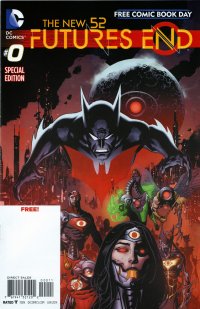 nostalgia buttons in such a delightful way. The story begins in media res, with Martian Manhunter, Stargirl, Animal Man, Green Arrow and Adam Strange already assembled in Moosonee, Ontario to combat an alien creature whose physical form is in constant flux (with allusions back to the classic origin issue, Justice League of America #9). This unusual team of B-roster characters seems ready to take it on, but unprepared to do it in a coordinated measure. There’s a Whedon-esque levity to the proceedings without undercutting the intensity of the action or the stakes involved. This feels like a New 52 iteration of the Giffen-DeMatteis era Justice League in that regard, and just like that series which ushered me headlong into the post-Crisis DC Universe, so to does Justice League United have that potential.
nostalgia buttons in such a delightful way. The story begins in media res, with Martian Manhunter, Stargirl, Animal Man, Green Arrow and Adam Strange already assembled in Moosonee, Ontario to combat an alien creature whose physical form is in constant flux (with allusions back to the classic origin issue, Justice League of America #9). This unusual team of B-roster characters seems ready to take it on, but unprepared to do it in a coordinated measure. There’s a Whedon-esque levity to the proceedings without undercutting the intensity of the action or the stakes involved. This feels like a New 52 iteration of the Giffen-DeMatteis era Justice League in that regard, and just like that series which ushered me headlong into the post-Crisis DC Universe, so to does Justice League United have that potential.
Writer (and Canadian) Jeff Lemire is one of DC’s most trusted resources right now, alongside Scott Snyder and Geoff Johns, and I imagine it’s in this position that he managed to convince the brass that a north of the border superhero team was a viable option. But, let’s be honest, Canada is a largely vast expanse of trees and rocks and water, with most of our meager population hugging the border to the US. We’re a rather peaceful nation and rarely a target of international scrutiny or concern. Despite our size we’re pretty innocuous, so what’s really going to happen here beyond the odd Yeti attack or pipeline disaster that will require Justice League-sized intervention? Lemire takes care of that by opening the book with a hardscrabble fight between Hawkman and Lobo in some kind of alien building or vessel that’s connected to the alien the “League” is fighting in Canada. It plants the seeds that an intergalactic adventure is in the offing, rather than a Canadian one. With Adam Strange on the roster, it’s a sure bet that space-faring is going to be a common occurrence.
Mike McKone is a veteran comics illustrator at this point, but a bit of a journeyman. He never seems to stay put too long but he’s always been a valuable resource wherever he’s landed. His style has evolved in recent years to be a little less accented, less busy, with a scaling back of the lines in his work, leaving more of the texture to the colorist. It’s a little more cartoonish now, more open, less detailed perhaps, which is a minor disappointment for those who appreciated his earlier work, but he’s still a capable storyteller and he nails the action and the comedy with equal aplomb (he’s a veteran of the Giffen-DeMatteis Justice League years, so of this there was no doubt).
It’s evident that Lemire has studied past Justice League starts, going back to the early issues of the first iteration of the team and again at the post-Crisis League and even Morrison’s JLA, and has brought a familiar and yet fresh team together with the purpose of producing entertaining comics. Lemire brings a lived-in feel to the characters, referring to recent events and their impact on the characters, as well as building up a dynamic between the players that makes me want to spend more time with them and this semi-unfamiliar Universe they get to play around in.
It should be no surprise then that with Lemire’s involvement in Future’s End, the second of three new weekly series from DC, also captures much of that same lived-in universe feel. Future’s End throws the reader around the DC Universe timeline, presenting in the “zero issue” an apocalyptic future where the Brother Eye satellite has created a nanovirus infection that is overtaking the global population. The last hope is that Batman can travel back in time and stop his younger self and Mister Terrific from creating the machine in the first place. It’s basically the premise of Terminator, but with spandex.
Batman succumbs to injuries before he can make his way to the past, so it’s up to his protege, Terry McGinnis to make the journey in his stead, and hopefully save the future. Terry has an on-board A.I. to aide him, codenamed A.L.F.R.E.D. (total shades of Iron Man and JARVIS), but after making the journey he’s informed that he’s not traveled back far enough and he’s five years forward from the “present day” in the DCU (what is it with DC and their blanket “5 years” time jumps?). So now his mission is not to sabotage Brother Eye’s creation but to convince his future mentor and a hero community at large that this thing needs to be destroyed. But that hero community in the wake of a major player’s death, is in flux. Egos start clashing at the funeral, while Stormwatch is been attacked in the farthest reaches of known space, Grifter seems to be caught up in a remake of They Live as he’s a one man execution squad against an alien invasion only he sees, and Firestorm is such a complete mess it’s easy to anticipate the threat he/they may become.
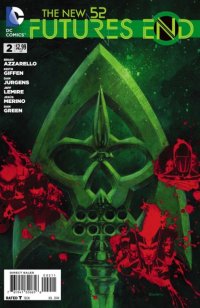 It’s not quite as heady as the great weekly 52 was, and the complete cop of a story arc from a film franchise that is still paying dividends should grant even further demerits, but Future’s End is just plain enjoyable. It’s got an interesting if oddly-matched brain trust in Lemire, Brian Azzarello, Keith Giffen and Dan Jurgens, which should make for a much different ride than 52 or any weekly that’s come since. Jurgens with his “Zero Hour” and “Armageddon 2001” (remember that?) experience back in the day is well versed in this type of future-hopping and universe-spanning adventure, while Giffen kickstarted the whole Annihilation franchise over at Marvel (and is the only holdover collaborator from 52). Lemire showed some gnarly apoco-future vision in his Animal Man/Swamp Thing crossover epic “Rotworld” so this is familiar terrain for him, and Azzarello showed a lot of love for the efforts of the 52 crew in his fantastic ode with Cliff Chiang, Doctor Thirteen, so in many ways this is a really logical assembly. In three issues, this weekly “event” book already feels like it’s coming together nicely, which is more than can be said about its sister weekly, Batman: Eternal.
It’s not quite as heady as the great weekly 52 was, and the complete cop of a story arc from a film franchise that is still paying dividends should grant even further demerits, but Future’s End is just plain enjoyable. It’s got an interesting if oddly-matched brain trust in Lemire, Brian Azzarello, Keith Giffen and Dan Jurgens, which should make for a much different ride than 52 or any weekly that’s come since. Jurgens with his “Zero Hour” and “Armageddon 2001” (remember that?) experience back in the day is well versed in this type of future-hopping and universe-spanning adventure, while Giffen kickstarted the whole Annihilation franchise over at Marvel (and is the only holdover collaborator from 52). Lemire showed some gnarly apoco-future vision in his Animal Man/Swamp Thing crossover epic “Rotworld” so this is familiar terrain for him, and Azzarello showed a lot of love for the efforts of the 52 crew in his fantastic ode with Cliff Chiang, Doctor Thirteen, so in many ways this is a really logical assembly. In three issues, this weekly “event” book already feels like it’s coming together nicely, which is more than can be said about its sister weekly, Batman: Eternal.
As far as the art goes, it seems to be rotating issue-by-issue, with Patrick Zircher, Jesus Merino, Aaron Lopresti and Jurgens alternating on penciling duties (unlike the 52 method which had different artists handling different arcs within each issue). But really, the point of these weekly series isn’t to deliver a collaborative writer-artist experience, but a collaborative writer experience, so the artists are yeomen, cranking out the story as fast as the writing team can assemble it. In some respects though the issue-by-issue rotation seems to be playing better than the by-the-arc method of the past. Certainly at this point it doesn’t look like Zircher or Merino (handling issue 1 and 2 respectively) is phoning it in, but it’s also not reaching the highest marks of their careers.
The overall effect of Future’s End and Justice League United being released this month (noting especially how the funeral scene this week seems to project a long — 5-years at least — life for Justice League United) is that the characters all seem comfortable in their world, and with each other. This all feels like an inviting an lived-in DCU, a place that I actually feel like spending time in, and that’s been too long in coming.
All Three: Rating: 




Out of a Possible 5 Stars
The Tick: Free Comic Book Day 2014 (NEC, Free – but if you didn’t get it at your local comic book store last week, you’ll need to send NEC a 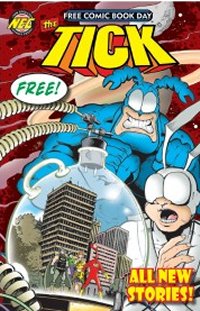 large self-addressed envelope with $1.40 in U.S. postage on the envelope to order it.)
large self-addressed envelope with $1.40 in U.S. postage on the envelope to order it.)
By Cat Taylor
As a pop culture geek, I love the months of April and May. Those are the months when I and many of my friends have our Birthdays, but more importantly those months also include Record Store Day and Free Comic Book Day. I am eternally grateful that almost every publisher, both large and small, offers at least one free book every year. In addition, let’s also not forget the comic stores that carry a large selection of these books for us because while the books are free to the customers, the retailers still have to pay the publishers for them.
The reason for that expository opening paragraph is to make my appreciation for everyone involved in Free Comic Book Day absolutely clear before reviewing a couple of the free books. I selected books that I thought were good. However, since no comic book is perfect I may offer a bit of “constructive criticism” and I don’t want to sound like an ungrateful jerk. After all, what do I expect for free? Well, after several years of Free Comic Book Days, I’ve come to expect a lot more for free from some publishers than others. One publisher I can always count on to deliver a free comic that is typically new material and that stands up well alongside their regular series is NEC. NEC is the home of the Tick as well as…well, pretty much just the Tick, but if you only have one title to your name, the Tick is a good one.
Even though the Tick has been around since 1986 and experienced massive exposure in the mid-90s, thanks to an outstanding cartoon adaptation, I haven’t seen a lot of the Tick in the last ten years. However, by participating in Free Comic Book Day, NEC is able to make it clear that the series is still around and is still good. Actually, most issues are better than good. What the Tick manages to do that many others have tried with typically so-so results, is produce an original superhero universe that is actually funny in both concept and execution. It doesn’t depend on one-liners, predictable parodies of other popular characters, or smart-ass meta commentary on the state of the comic book industry for its material.
With the exception of the Tick himself, almost all of the heroes in the Tick universe have superpowers that are completely useless in crime fighting. While the Tick himself is super-strong and nigh invulnerable he also happens to be a complete moron with no sense of reality. So, the comedy almost writes itself. I say “almost” writes itself because the current writer is Jeff McClelland and he does an admirable job of crafting a story that is as consistently funny and fitting of the tone I’m used to finding in a Tick comic. Likewise, the art style of the Tick hasn’t changed significantly since the creation of the series. While such an established style doesn’t encourage individual artistic styles, I think the consistency is very important to this series more than most. Artist, Duane Redhead honors the distinctive comedy art style originally established by creator Ben Edlund back in 1986. This consistency permeates the quality of the Tick all around. That’s why year-to-year you can count on the Tick to offer one of the better free comic books on Free Comic Book Day and you can feel comfortable knowing that if you enjoy the free issue, you’ll enjoy the regular series at least as much.
Rating: 




Out of a Possible 5 Stars
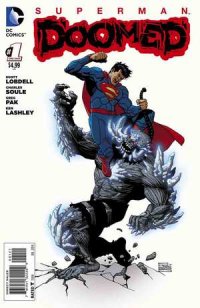 Superman: Doomed #1 ($4.99, DC)
Superman: Doomed #1 ($4.99, DC)
Action Comics #31 ($3.99, DC)
Superman/Wonder Woman #8 ($3.99, DC)
by D.S. Randlett (@dsrandlett)
You know who kind of sucked? Doomsday. Now, I don’t quite hold The Death and Return of Superman to be quite the laughing stock that it has become. I’m thankful that it gave us Steel and Superboy, for example, and large swaths of that epic are pretty fun. But Doomsday. Created to be the ultimate avatar of brute force, he would go on to become one of Superman’s most iconic villains in the modern era by dint of the fact that, well, he “killed” Superman. To this day, whenever a new Superman movie is on the horizon, Doomsday rumors pop up, or else the clamoring of a certain set of fans. The problem was that Doomsday never meant or stood for anything. As a character, Superman has more or less evolved into a character whose greatest struggles are ideological and metaphorical, and his better stories tend to reflect this. All Star Superman is (among other things) about the acceptance of mortality, the unfinished Superman Unchained is about a citizen reckoning with his own country’s imperial past. The Death of Superman was about nothing but Superman’s unwillingness to give up against a threat. While this is unquestionably virtuous and thrilling in its way, it still feels cheap given the gravity of the principal character.
Comics being what they are, Doomsday was never destined to stay dead. The character would return and his backstory would be fleshed out. He would take on new abilities, become more intelligent, and present new challenges. But much like Bane would only ever be used after Knightfall to trade in on the cache of being the man who “broke the Bat” for some cheap drama points, Doomsday would appear in DCU stories like Infinite Crisis as a cheap shorthand for things being really, really dire. When the 3-month Doomed crossover was announced, I didn’t know how to feel. On the one hand, Scott Lobdell’s run on Superman had been pretty bad and he’d have a hand in this. But on the other, Greg Pak and Charles Soule have revitalized the character after a pretty trepidatious start after the New 52 relaunch. Morrison’s run aside, DC saw fit to run a bunch of experiments on the character, but Pak and Soule have managed to find the core of the character again in their respective books while working within the confines and strictures of the New 52. And Doomsday hung over it all.
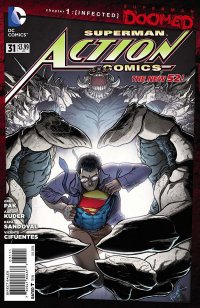 The first Doomed bookend introduces things rather effectively and surprisingly, condensing the original Death of Superman story’s rhythms and conflicts into a single oversized issue. The script feels very Lobdell in its voice, but Pak and Soule’s fingerprints are all over the plotting. Much like the original Death of Superman story, this Doomed issue can be easily summarized: a big space monster is here, and only Superman can possibly stop it (although, it is nice seeing the Justice League be, y’know, the Justice League for once). But where the original story was all about building to the Big Fight, which is what closes Doomed #1, this iteration seeks to use that moment as a launchpad for the real story. Where the writers flip the script here is by making Doomsday something other than a boney Hulk ripoff: they make him a weird “planet killer” creature with an insect-like life cycle. Once Superman defeats the monster, he breathes in a cloud of spores. While Doomsday is dead, it is not gone.
The first Doomed bookend introduces things rather effectively and surprisingly, condensing the original Death of Superman story’s rhythms and conflicts into a single oversized issue. The script feels very Lobdell in its voice, but Pak and Soule’s fingerprints are all over the plotting. Much like the original Death of Superman story, this Doomed issue can be easily summarized: a big space monster is here, and only Superman can possibly stop it (although, it is nice seeing the Justice League be, y’know, the Justice League for once). But where the original story was all about building to the Big Fight, which is what closes Doomed #1, this iteration seeks to use that moment as a launchpad for the real story. Where the writers flip the script here is by making Doomsday something other than a boney Hulk ripoff: they make him a weird “planet killer” creature with an insect-like life cycle. Once Superman defeats the monster, he breathes in a cloud of spores. While Doomsday is dead, it is not gone.
The story really comes alive in Action Comics and Superman/Wonder Woman, which each read like cohesive parts of the same story, Instead of the typical grandstanding one expects from big events like this, each of these issues is remarkably character focused while still enticing in terms of plot. Pak’s script on Action focuses mainly on Superman’s struggle with this new influence coursing through his body. He’s having more aggressive thoughts, and it’s starting to change him physically into something more like, well, Doomsday. As ever, Aaron Kuder’s art is a joy to behold. In his hands, the contrast between Superman classic and the infected Superman is pretty stark, as he captures a subtle difference in the mannerisms of Superman’s different mental states.
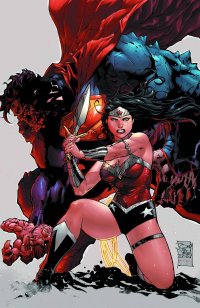 The stakes advance in the pages of Superman/Wonder Woman, where the view of Superman’s condition is seen from the outside. Regardless of whether or not you think Superman and Wonder Woman should be dating, there’s no question the Charles Soule’s take on that idea has been surprisingly solid. But then maybe it’s not surprising at all, as Soule is a talented guy. Here he explores the events from Wonder Woman’s perspective. Superman is more distant and withdrawn, and it’s touching to see Wonder Woman scour the globe in search of him in both her tights and her civvies. Eventually she finds him, mutated almost beyond recognition, saying things that Superman might think on his bad days, but never really say. Here’s it’s apparent that the team behind this event have found a suitable metaphor for Doomsday. In Soule’s script for Superman/Wonder Woman, Doomsday is personal entropy. Doomsday is depression. And while we can say that and then joke about “emo Superman,” it doesn’t read like that at all here. Superman is dealing with what all too many people deal with: having a force inside them that makes them not themselves. Not everyone makes it out alive. While Tony Daniel is very evocative of the current DC “house style,” he acquits himself here with aplomb, capturing Wonder Woman’s resolve and compassion quite effectively, and the scenes involving the mutated Superman evoke a real sense of despair.
The stakes advance in the pages of Superman/Wonder Woman, where the view of Superman’s condition is seen from the outside. Regardless of whether or not you think Superman and Wonder Woman should be dating, there’s no question the Charles Soule’s take on that idea has been surprisingly solid. But then maybe it’s not surprising at all, as Soule is a talented guy. Here he explores the events from Wonder Woman’s perspective. Superman is more distant and withdrawn, and it’s touching to see Wonder Woman scour the globe in search of him in both her tights and her civvies. Eventually she finds him, mutated almost beyond recognition, saying things that Superman might think on his bad days, but never really say. Here’s it’s apparent that the team behind this event have found a suitable metaphor for Doomsday. In Soule’s script for Superman/Wonder Woman, Doomsday is personal entropy. Doomsday is depression. And while we can say that and then joke about “emo Superman,” it doesn’t read like that at all here. Superman is dealing with what all too many people deal with: having a force inside them that makes them not themselves. Not everyone makes it out alive. While Tony Daniel is very evocative of the current DC “house style,” he acquits himself here with aplomb, capturing Wonder Woman’s resolve and compassion quite effectively, and the scenes involving the mutated Superman evoke a real sense of despair.
Doomed is shaping up to be a crossover unlike any other: epic in scope and stakes, yet still retaining a sense of the intimate. With writers like Greg Pak and Charles Soule leading the charge, this may be worth continuing to look into.
Doomed #1 Rating: 




Out of a Possible 5 Stars
Action Comics #31 Rating: 




Out of a Possible 5 Stars
Superman/Wonder Woman #8 Rating: 




Out of a Possible 5 Stars
Hellboy 20th Anniversary Sampler (Dark Horse, Free)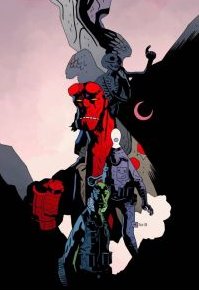
By Cat Taylor
Although this was another great find for me on Free Comic Book Day, this free issue actually came out in March. However, I missed it then and one of my local comic shops had leftovers that they added to stacks of giveaways this year. I’m glad it was available again because it was one of the best of this year’s finds.
Hellboy serves as a shining example of an independent comic book success story to which most others can only aspire. This sampler contains three short stories (one brand new and two reprints) plus a section of short Hellboy parody comics done in the style of various well-known Sunday newspaper funnies, including Peanuts, Ziggy, and Family Circus.
The three main stories in this anthology are all written by series creator, Mike Mignola and Mignola also handles the art chores on one of the tales. The first story in the book is the newest tale called “Coffin Man.” The other two stories are the “Ghoul” and “Another Day at the Office” and those have been previously printed elsewhere. While these three stories are all very short, and the last one doesn’t even feature Hellboy, they all have certain quirks that are indicative of the regular Hellboy comic series. The most notable of these quirks are the paranormal plots with resolutions that aren’t the clean, neat, and conclusive endings that are typically found in Western literature. There are lots of comics about otherworldly types dealing with paranormal situations, but it requires unique twists on the concepts and characters, as well as creative stories to make a book like Hellboy a success. In addition to interesting stories, the artwork by all three artists fits the tone of the stories. Even though each artist has his own style there is a consistency to the work that looks like it would feel at home in any of DC’s Vertigo books. In fact, I imagine that if Mignola ever wanted to leave Dark Horse, Hellboy would be a welcome addition to the Vertigo imprint.
I could attempt to explain the concept of the Hellboy character and the Bureau for Paranormal Research and Defense organization that the character works for. However, like my attempts to explain what makes Hellboy so enjoyable above, I am certain that a written explanation from me wouldn’t do it justice. The only way to truly appreciate a book like this is to check it out for yourself, and that’s exactly why Free Comic Book Day is so terrific. You can check out great titles for yourself, at no cost, and not have to wonder if you would like a book just because a goof like me thinks you should. In this case though, you should.
Rating: 




Out of a Possible 5 Stars